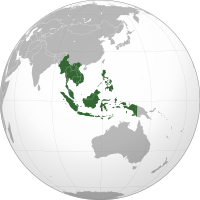
Photo from wikipedia
Abstract Ozone (O 3 ) is an important ground-level pollutant. O 3 levels and emissions of O 3 precursors have increased significantly over recent decades in East Asia and export… Click to show full abstract
Abstract Ozone (O 3 ) is an important ground-level pollutant. O 3 levels and emissions of O 3 precursors have increased significantly over recent decades in East Asia and export of this O 3 eastward across the Pacific Ocean is well documented. Here we show that East Asian O 3 is also transported southward to tropical Southeast (SE) Asia during the Northeast Monsoon (NEM) season (defined as November to February), and that this transport pathway is especially strong during ‘cold surges’. Our analysis employs reanalysis data and measurements from surface sites in Peninsular Malaysia, both covering 2003–2012, along with trajectory calculations. Using a cold surge index (northerly winds at 925 hPa averaged over 105–110°E, 5°N) to define sub-seasonal strengthening of the NEM winds, we find the largest changes in a region covering much of the Indochinese Peninsula and surrounding seas. Here, the levels of O 3 and another key pollutant, carbon monoxide, calculated by the Monitoring Atmospheric Composition and Climate (MACC) Reanalysis are on average elevated by, respectively, >40% (∼15 ppb) and >60% (∼80 ppb) during cold surges. Further, in the broader region of SE Asia local afternoon exceedances of the World Health Organization's air quality guideline for O 3 (100 μg m −3 , or ∼50 ppb, averaged over 8 h) largely occur during these cold surges. Day-to-day variations in available O 3 observations at surface sites on the east coast of Peninsular Malaysia and in corresponding parts of the MACC Reanalysis are similar, and are clearly linked to cold surges. However, observed O 3 levels are typically ∼10–20 ppb lower than the MACC Reanalysis. We show that these observations are also subject to influence from local urban pollution. In agreement with past work, we find year-to-year variations in cold surge activity related to the El Nino-Southern Oscillation (ENSO), but this does not appear to be the dominant influence of ENSO on atmospheric composition in this region. Overall, our study indicates that the influence of East Asian pollution on air quality in SE Asia during the NEM could be at least as large as the corresponding, well-studied spring-time influence on North America. Both an enhanced regional observational capability and chemical modelling studies will be required to fully untangle the importance of this long-range influence relative to local processes.
Journal Title: Atmospheric Environment
Year Published: 2017
Link to full text (if available)
Share on Social Media: Sign Up to like & get
recommendations!